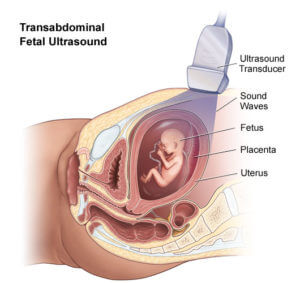What is the First Trimester Screening?
First Trimester Screening (FTS) is a combination of antenatal tests which includes an early ultrasound scan and a blood test. It provides information about the health of the baby.
What does FTS tell me about my baby?
FTS identifies women who may have an increased risk of having a baby with Down syndrome or cardiac defects. They can then be offered a diagnostic test such as amnio-centesis to confirm the birth defect.
First Trimester Screening
 How FTS is done?
How FTS is done?
- a) Early ultrasound scan done between 11 and 13 weeks 6 days (crown-to-rump length between 40 and 84 mm) of pregnancy involves measurement of the nuchal translucency (fluid-filled space beneath the skin behind the neck). A large nuchal translucency measurement may be an indication of chromosomal abnormality (such as Down syndrome) or heart problem in the baby. During the nuchal scan, the nasal bone is also checked to see if it is present. Recent studies have shown that the nasal bone is absent in 3 of 4 babies with Down syndrome during this time. The general anatomy will be checked to look for any physical (structural) abnormalities. The head, limbs, spine and the abdomen will be examined. The nuchal translucency is measured using the abdominal probe. This requires a relatively full bladder but not to the extent that you feel uncomfortable.
- b) The First Trimester blood test 5 mls of blood is drawn from the arm to measure the levels of two hormones normally found in all pregnant women which are the Pregnancy Associated Plasma Protein-A (PAPP-A) and free beta-subunit of human chorionic Gonadotrophin (free P-hCG). Usually in Down syndrome cases, the free p-hCG level is relatively high and the PAPP-A level is relatively low.
When is this test done?
FTS is performed between 11 weeks and 13 weeks 6 days. An ultrasound scan is done to confirm the gestation of the pregnancy and measure the nuchal translucency.
How is the risk calculated?
The nuchal trariclucency measurement is entered into a dedicated computer risk calculation program together with other parameters such as the crown-to-rump length, maternal age and weight. The blood levels of the two hormones are also entered into this program. The computer would then calculate a personalized risk based on these parameters.
How do I interpret the result?
A positive screen or high risk result does not mean that your baby has Down syndrome but has an increased risk of being affected. You may wish to consider having a diagnostic test such as amniocentesis or Chorionic Villus Sampling (CVS). A negative screen or low risk result does not mean your baby does not have Down syndrome but the likelihood of the baby being affected is small.
What are the Diagnostic Tests?
“Diagnostic tests” are confirmatory tests which are offered to mothers considered to be at high risk of having a baby with a chromosomal problem. Diagnostic tests are invasive and such, there is a risk of miscarriage. However, diagnostic tests do give a conclusive answer whether your baby is truly affected and the risk of miscarriage is only 1 in 100 (1%).
Chorionic villus sampling (CVS) involves taking a sample of some of the placental tissue. This tissue contains the same genetic material as the fetus and can be tested for chromo-somal abnormalities and some other genetic problems. CVS is usually performed between the 10th and 12th weeks of pregnancy. Tissues are obtained by passing a long needle through the abdomen or occasionally a small tube through the vagina, to sample the placental cells.
An amniocentesis is a procedure that involves inserting a thin needle through the mother’s abdomen into the amniotic sac to withdraw a small sample of the amniotic fluid for examination. The amniotic fluid contains cells shed by the fetus, which contain genetic information. Skin cells from within this fluid are filtered and examined. Amniocentesis is performed between the 15th and 20th weeks of pregnancy and able to identify a wide range of chromosomal abnormalities.
How good or reliable is FTS?
A combination of tests in the first trimester of pregnancy is the most sensitive in the detection of Down syndrome as shown below:
- Method of Screening / Detection Rate (Sensitivity)
- Maternal Age + PAPP-A + free β-hCG + NT (+ NB) / 60% detection rate
- Maternal Age + NT / 70-80% detection rate
- Maternal Age + PAPP-A + free β-hCG + NT (+ NB) / 95% detection rate
*NT – NUCHAL TRANSLUCENCY
*NB – NASAL BONE
What are the advantages of doing FTS?
- Non-invasive – Only 5m1 maternal blood is needed
- Safe – No risk of miscarriage
- Early Screening – Can be done as early as 11 week of gestation age
- Accurate – Nuchal Scan + blood test give 95% accurate result
Should I also have the second trimester screening blood test?
No. This is not recommended because it may lead to great confusion and anxiety over your risk of having a baby with Down syndrome. The risk predicted from your nuchal translucency measurement is considered more accurate than the risk of the second trimester screening blood test would give you.
Reference: 1, Ntcoiaides K.H., The 11.134 weeks scan, Fetal Medicine Foundation 2004, Chapter 1- First trimester diagnosis of chromosomal deects.



Add a Comment